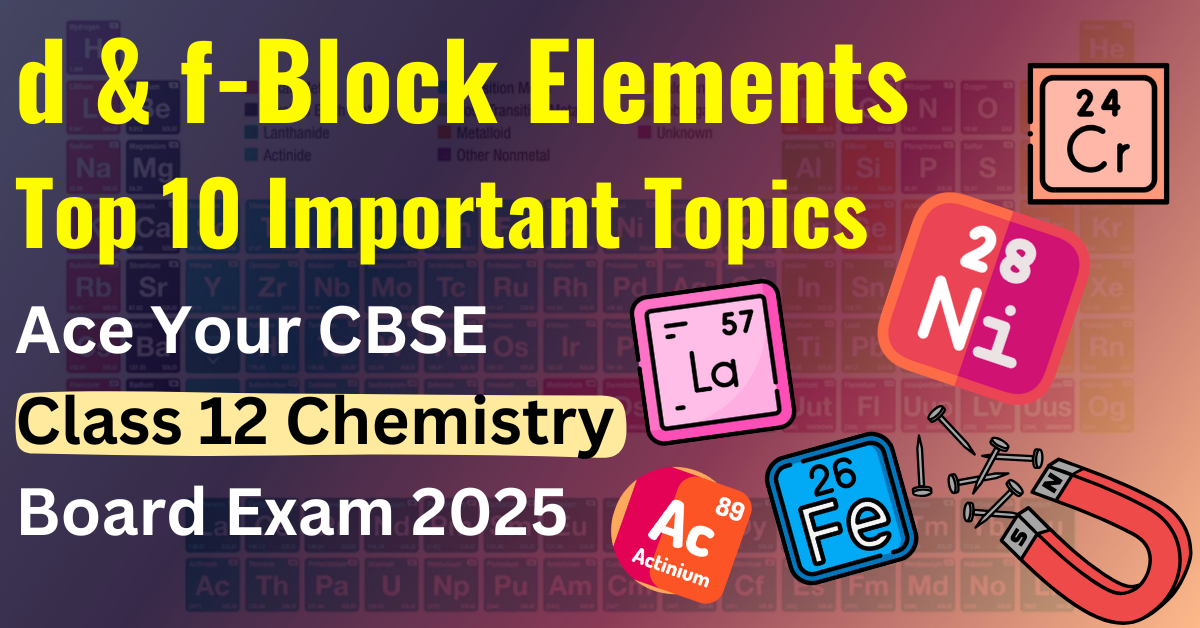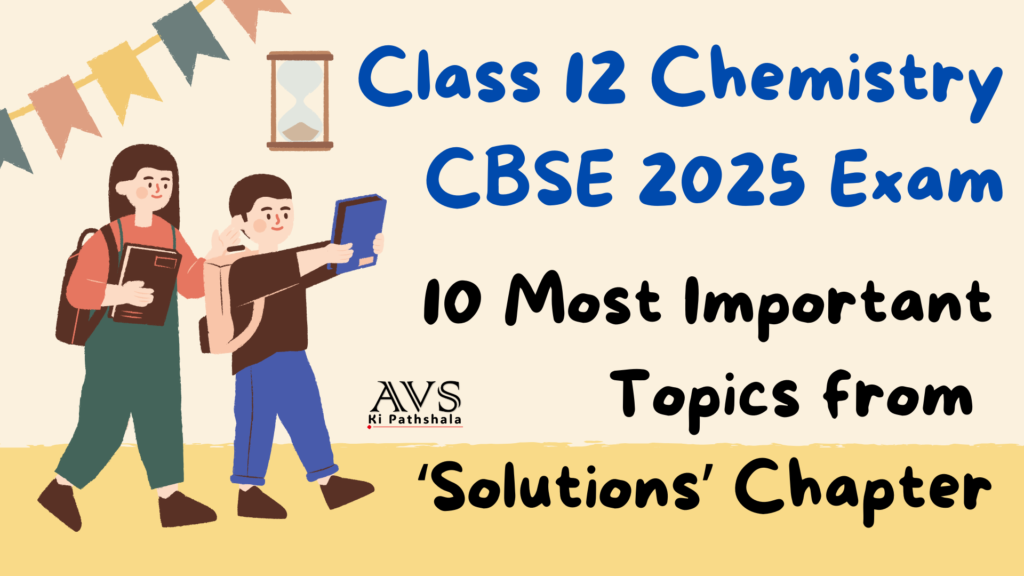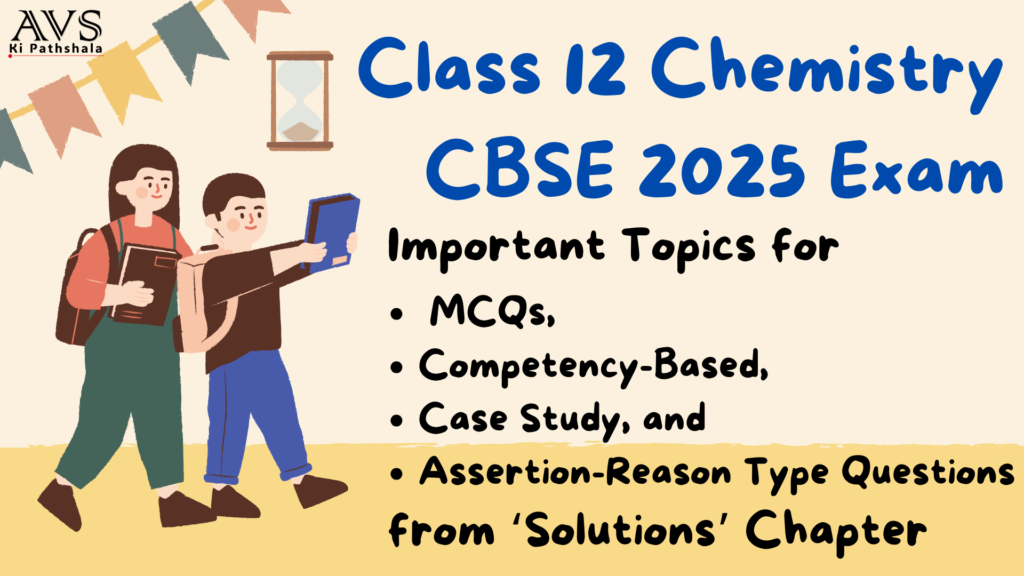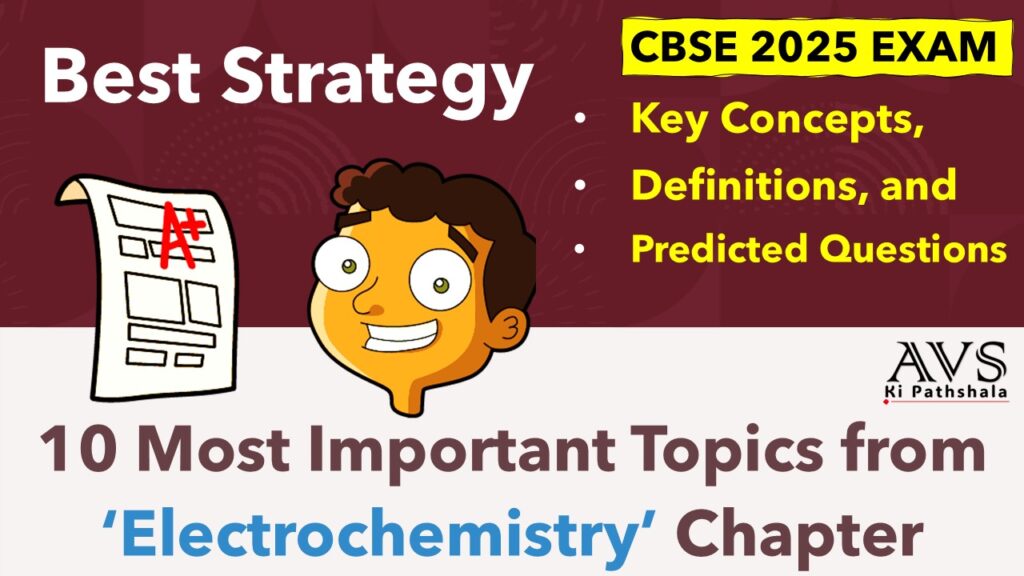d & f-Block Elements Top 10 Important Topics
The chapter on “d and f Block Elements” is a crucial part of the Class 12 CBSE Chemistry syllabus. With consistent weightage in board exams, it demands a thorough understanding of both theoretical and application-based concepts. This chapter explores the properties, uses, and chemistry of transition elements (d-block) and inner transition elements (f-block). Questions from this section often range from basic conceptual understanding to in-depth applications involving electronic configurations and chemical reactivity. In this guide, we have analyzed previous year papers and identified the 10 most likely topics that can be asked in the CBSE 2025 board exams.
10 Most Important Topics from ‘d and f-Block Elements’
1. General Characteristics of d-Block Elements
-
- Type of Questions: Conceptual and Short Answer (1–2 marks).
- Definition: Transition elements are those that have partially filled d-orbitals.
- Key Points: Discuss properties such as variable oxidation states, formation of colored compounds, and catalytic behavior.
- Previous Year Analysis: Questions frequently focus on electronic configuration and trends in the periodic table.
2. Electronic Configurations of d-Block Elements
-
-
- Type of Questions: Numerical and Long Answer (3–4 marks).
- Formula: For a general element of the d-block, the electronic configuration is written as [Noble gas core] (n−1)d1−10 ns0-2.
- Key Points: Predict the configurations and exceptions (e.g., Cr, Cu).
- Previous Year Analysis: Predicting the configuration of elements, filling anomalies.
-
3. Trends in Properties of Transition Elements (Ionization Enthalpy, Atomic Radius, etc.)
-
- Type of Questions: Short Answer and Numerical (2–3 marks).
- Key Points: Comparative trends of properties like ionization energy, atomic/ionic radii, and density.
- Important Formulas: Dependence of atomic size on effective nuclear charge.
- Previous Year Analysis: Application-based questions comparing elements like Fe, Cu, Zn.
4. Oxidation States of d-Block Elements
-
- Type of Questions: Conceptual and Long Answer (3–5 marks).
- Key Points: Stability of oxidation states, examples from groups (e.g., Mn showing +2 to +7 states).
- Previous Year Analysis: Trends and explanation of why certain oxidation states are favored.
5. Coordination Compounds of Transition Elements
-
- Type of Questions: Short Answer and Application (2–3 marks).
- Definition: Compounds where transition metals form coordinate bonds with ligands.
- Key Points: Role of d-orbitals in complex formation, hybridization.
- Previous Year Analysis: Structure, nomenclature, and applications of complexes.
6. Magnetic Properties of d-Block Elements
-
- Type of Questions: Conceptual (2–3 marks).
- Key Points: Paramagnetism and diamagnetism based on unpaired electrons.
- Formula: Magnetic moment μ= √n(n+2) BM (Bohr Magneton).
- Previous Year Analysis: Magnetic moment calculations and qualitative questions.
7. Color and Catalytic Properties of Transition Elements
-
- Type of Questions: Short Answer (2 marks).
- Key Points: Relation of color to d-d transitions and catalysts to variable oxidation states.
- Previous Year Analysis: Explaining color of complexes and role in catalysis (e.g., V2O5 in the Contact Process).
8. Lanthanides: Properties and Separation
-
- Type of Questions: Conceptual and Long Answer (3–4 marks).
- Key Points: Lanthanide contraction, oxidation states, and separation via ion-exchange or solvent extraction.
- Previous Year Analysis: Trends in properties and the importance of lanthanide contraction.
9. Actinides: Comparison with Lanthanides
-
- Type of Questions: Conceptual and Short Answer (1–3 marks).
- Key Points: Similarities and differences between lanthanides and actinides, oxidation states, and radioactivity.
- Previous Year Analysis: Comparison-based questions, general properties, and extraction.
10. Complex Formation in f-Block Elements
-
- Type of Questions: Long Answer (3–5 marks).
- Key Points: Coordination compounds, typical ligands, and role of f-orbitals in bonding.
- Previous Year Analysis: Questions on the role of inner transition metals in complex formation.
Important Topics for MCQs, Competency-Based, Case Study, and Assertion-Reason Questions
In CBSE Class 12 Chemistry, the “d and f Block Elements” chapter covers several topics that are likely to be tested in different formats, such as MCQs, competency-based, case study-based, and assertion-reason type questions. Here’s a breakdown of which topics are most important for each question type:
1. Multiple Choice Questions (MCQs)
- Topic: Electronic Configurations of d-Block Elements
- Why Important: MCQs often ask students to identify correct electronic configurations or spot exceptions, such as Cr and Cu.
- Sample MCQ: What is the electronic configuration of Cu in its ground state?
- (a) [Ar] 3d10 4s1
- (b) [Ar] 3d9 4s2
- (c) [Ar] 3d8 4s2
- (d) [Ar] 3d10 4s0
- Topic: Oxidation States of d-Block Elements
- Why Important: Students are frequently asked to identify the most stable oxidation state for a given transition metal.
- Sample MCQ: Which of the following oxidation states is common for all d-block elements?
- (a) +1
- (b) +2
- (c) +3
- (d) +4
- Topic: Color of Transition Metal Ions
- Why Important: Color of metal ions due to d-d transitions is a frequent topic for quick, fact-based questions.
- Sample MCQ: The color of Fe2+ ions is due to:
- (a) Charge transfer
- (b) d-d transitions
- (c) f-f transitions
- (d) p-p transitions
2. Competency-Based Questions
- Topic: Magnetic Properties of d-Block Elements
- Why Important: Competency-based questions often involve applying the concept of magnetic properties to calculate or predict behavior.
- Sample Competency Question: A compound shows a magnetic moment of 2.83 BM. How many unpaired electrons are present in the metal ion?
- Topic: Catalytic Properties of Transition Elements
- Why Important: Students may be asked to analyze a process like the Haber process or Contact process and explain why transition metals are effective catalysts.
- Sample Competency Question: Explain why V2O5 is used as a catalyst in the Contact process. How does its variable oxidation state play a role?
- Topic: Trends in Properties (Ionization Enthalpy, Atomic Radii)
- Why Important: These trends can be used to predict chemical behavior and competency-based reasoning questions.
- Sample Competency Question: Why does the first ionization energy decrease down the group for transition elements, but the second ionization energy shows an increase?
3. Case Study-Based Questions
- Topic: Coordination Compounds and Their Applications
- Why Important: Case studies may describe a real-world application of coordination compounds, such as in medicine (cisplatin) or industry (catalysts).
- Sample Case Study Question: A coordination compound is used in chemotherapy for cancer treatment. Identify the compound and explain its mechanism of action.
- Topic: Separation of Lanthanides and Actinides
- Why Important: A case study can discuss the separation techniques of lanthanides or their applications in technology, requiring students to apply their knowledge.
- Sample Case Study Question: In the extraction of lanthanides, ion-exchange and solvent extraction methods are commonly used. Explain why separation is difficult and how lanthanide contraction affects the process.
4. Assertion-Reason Type Questions
- Topic: Lanthanide Contraction
- Why Important: Assertion-reason questions often test whether students can relate the contraction to its effects on chemical properties.
- Sample Assertion-Reason Question:
Assertion: Lanthanide contraction leads to a decrease in atomic radii.
Reason: This contraction is due to poor shielding by f-electrons.- Both assertion and reason are true, and the reason is the correct explanation of the assertion.
- Both assertion and reason are true, but the reason is not the correct explanation.
- The assertion is true, but the reason is false.
- Both assertion and reason are false.
- Topic: Variable Oxidation States in d-Block Elements
- Why Important: Assertion-reason questions commonly focus on the varied oxidation states and their stability.
- Sample Assertion-Reason Question:
Assertion: Mn exhibits the maximum number of oxidation states in the 3d series.
Reason: This is because Mn has the highest number of unpaired electrons.- Both assertion and reason are true, and the reason is the correct explanation.
- Both assertion and reason are true, but the reason is not the correct explanation.
- The assertion is true, but the reason is false.
- Both assertion and reason are false.
- Topic: Magnetic Properties of d-Block Elements
- Why Important: Questions could test understanding of why certain elements are paramagnetic or diamagnetic.
- Sample Assertion-Reason Question:
Assertion: Zn2+ is diamagnetic.
Reason: Zn2+ has no unpaired electrons in its d-orbital.- Both assertion and reason are true, and the reason is the correct explanation.
- Both assertion and reason are true, but the reason is not the correct explanation.
- The assertion is true, but the reason is false.
- Both assertion and reason are false.
Important Points to Remember:
- Oxidation States: The stability of high oxidation states decreases across the series (Mn > Fe > Co).
- Lanthanide Contraction: This leads to a decrease in atomic and ionic radii, which influences the chemical properties of the elements.
- Electronic Configurations: Pay special attention to irregularities in the configuration of Cr and Cu.
- Magnetic Properties: More unpaired electrons result in a stronger magnetic moment.
- Catalysis: Transition metals and their compounds act as good catalysts due to their ability to change oxidation states.
Conclusion
The “d and f-Block Elements” chapter is heavily application-based, making it crucial to understand trends and behaviors of transition and inner transition metals. While direct questions on electronic configurations, oxidation states, and magnetic properties have been common, CBSE is known to focus on comparative and reasoning-based questions in recent years. By mastering these key topics, students can confidently attempt the 2025 board exams. Additionally, practicing numerical problems related to magnetic moments and electronic configurations will ensure high scores in these segments.
To excel in the 2025 CBSE board exams, it’s essential to understand which topics are likely to appear in different question formats. Topics like electronic configurations, oxidation states, and trends in properties are likely to be asked in MCQs. Concepts involving magnetic properties and catalysis may appear in competency-based questions, while case studies are more focused on coordination compounds and separation techniques. Finally, assertion-reason questions commonly revolve around critical concepts like lanthanide contraction and oxidation states. By preparing each topic with a focus on the expected format, students can tackle any type of question with confidence.
To enhance your preparation even further for CBSE 2025 Exam, you can also connect with us on YouTube, where we will guide you through all these topics in a comprehensive manner. To join us on YouTube, simply click the link below, and you’ve already taken your first step towards scoring better marks.
In the next post, we will discuss the key topics of the chapter ‘Coordination Compounds’.
Note: All the topics covered in this article are based on the “d and f-Block Elements” chapter of Class 12 Chemistry CBSE Board and have been curated after analyzing previous years question papers. This article can be helpful for students aiming for success in exams, but it’s also important to thoroughly understand the entire syllabus and practice regularly.
Best wishes to all students!
Thank you!





